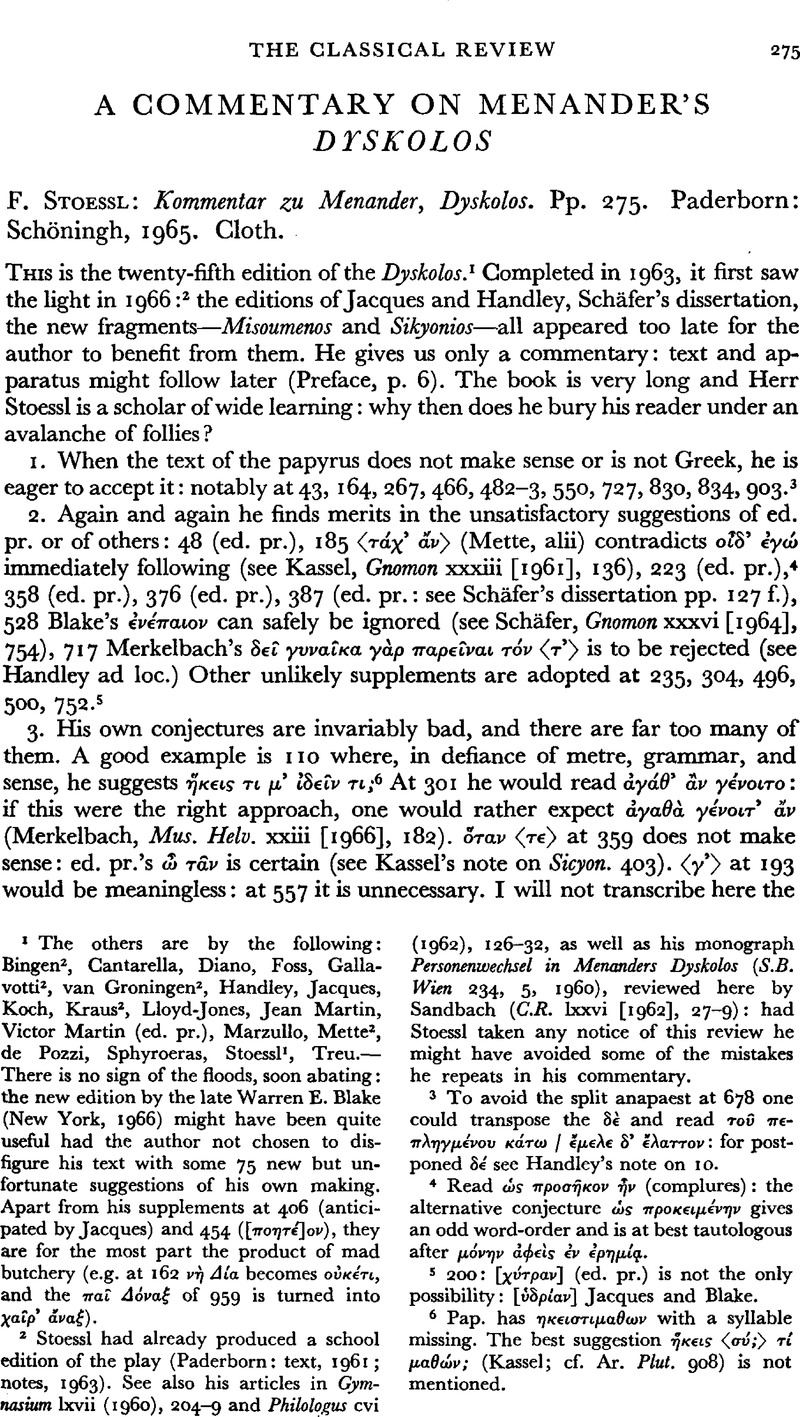No CrossRef data available.
Published online by Cambridge University Press: 27 February 2009

page 275 note 1 The others are by the following: Bingen2, Cantarella, Diano, Foss, Galla-votti2, van Groningen2, Handley, Jacques, Koch, Kraus2, Lloyd-Jones, Jean Martin, Victor Martin (ed. pr.), Marzullo, Mette2, de Pozzi, Sphyroeras, Stoessl1, Treu.—There is no sign of the floods, soon abating: the new edition by the late Warren E. Blake (New York, 1966) might have been quite useful had the author not chosen to disfigure his text with some 75 new but unfortunate suggestions of his own making. Apart from his supplements at 406 (anticipated by Jacques) and 454 ([ποητ⋯]ον), they are for the most part the product of mad butchery (e.g. at 162 ν⋯ Δ⋯α becomes οὐκ⋯τι, and the παῖ Δ⋯ναξ of 959 is turned into χαῖρ' ἄναξ).
page 275 note 2 Stoessl had already produced a school edition of the play (Paderborn: text, 1961; notes, 1963). See also his articles in Gymnasium lxvii (1960), 204–9 and Philologus cvi(1962), 126–32, as well as his monograph Personenwechsel in Menanders Dyskolos (S.B. Wien 234, 5, 1960), reviewed here by Sandbach (C.R. lxxvi [1962], 27–9): had Stoessl taken any notice of this review he might have avoided some of the mistakes he repeats in his commentary.
page 275 note 3 To avoid the split anapaest at 678 one could transpose the δ⋯ and read το⋯ πεπληγμ⋯νου κ⋯τω / ἔμελε δ᾽ ἔλαττον: for postfigure poned δ⋯ see Handley's note on 10.
page 275 note 4 Read ὡς προσ⋯κον ἦν (complures): the alternative conjecture ὡς προκειμ⋯νην gives an odd word-order and is at best tautologous after μ⋯νην ⋯φé⋯ς ⋯ν ⋯ρημ⋯ᾳ.
page 275 note 5 200: [χ⋯τραν] (ed. pr.) is not the only possibility: [ὑδρ⋯αν] Jacques and Blake.
page 275 note 6 Pap. has ηκειστιμαθων with a syllable missing. The best suggestionἥκεις 〈σ⋯;〉 τ⋯ μαθών; (Kassel; cf. Ar. Plut. 908) is not mentioned.
page 276 note 2 His ⋯νθαδ⋯ at 89 was anticipated by Jacques (⋯νθ⋯δε ed. pr.). His αὗται. at 445 is not as good as Lloyd-Jones's ⋯é⋯.
page 276 note 3 ‘What prompts Daos' violent reaction of fear must surely be a move towards Knemon's house’ (Handley, p. 177). So read perhaps ἔλθωμε]ν.
page 276 note 4 Arnott differs (Mnemosyne xix [1966], 396).
page 276 note 5 For the self-apostrophe at 214 ff. see the references given in Gnomon xxxix [1967], 122.
page 276 note 6 e.g. at 177, 213, 638. See further Jacques, p. 50, n. 2 and Blake, p. 4, n. 4.
page 276 note 7 378: ⋯π⋯σωσας is to be given to Sostratos, not to Daos (see Schäfer's dissertation, p. 127).
page 277 note 1 See Lloyd-Jones, , J.H.S. lxxxiv (1964), 28.Google Scholar
page 277 note 2 p. 54: for Oguze read Oguse; p. 55: for 〈⋯θ'〉 read 〈⋯δ'〉; p. 159: for Chambrun read Chambry; p. 191: Papagraphos (sic); etc.